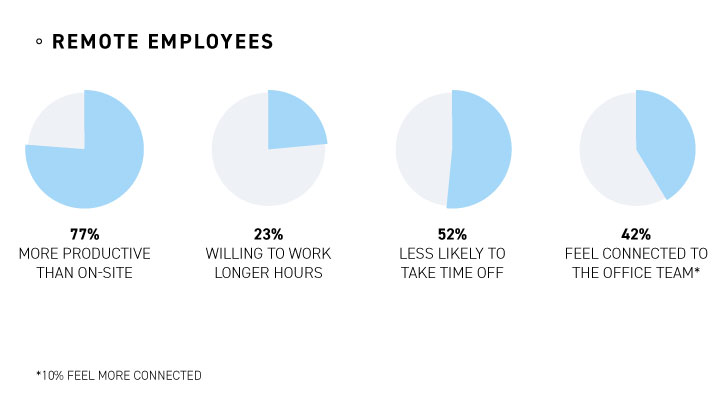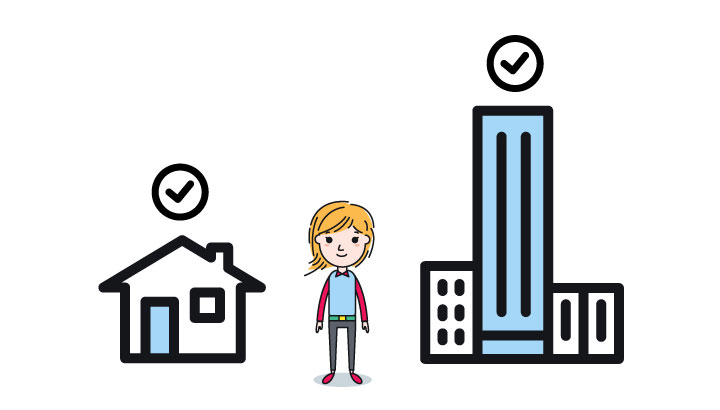Remote workers rule today’s job market. According to a Global Workplace Analytics report remote work in the U.S. has increased 140% since 2005. While it may not be the norm in your company, the world around us has gradually changed so that remote work is not only desired by employees, but it’s the new normal for employers seeking an increase in worker productivity.
Having the option of remote work is a huge attractant for potential talent. According to a Softchoice Research study 74% of North American office workers said they would change jobs based on the company’s work-from-home policies. Another study showed that workers would select a remote work option over a cash bonus.
But is working from home really productive? Can employers that offer this option trust their workers not to slack off? What does it take for companies to introduce these newer work models?
If your company still finds itself afraid to offer a remote work option, here’s what you need to consider.
Common Misconceptions About Remote Work Teams
 There’s a myth out there that people who work from home or somewhere other than the office take advantage of their employer. Some employers worry that working with a remote team will cause a host of problems, such as:
There’s a myth out there that people who work from home or somewhere other than the office take advantage of their employer. Some employers worry that working with a remote team will cause a host of problems, such as:- A decline in company culture
- Decreased productivity
- Weakened communication
But here’s the rub: Enough studies have been done in the last decade to provide and then validate the data that shows these employer concerns don’t hold water.
For example, a 2015 CoSo Cloud study reported:
- 77% of employees that worked remotely a few times a month were more productive than their on-site counterparts.
- 23% of workers were willing to work longer hours at home.
- 52% were less likely to take time off when they worked remotely.
- 42% said they felt just as connected to the home office team and 10% reported they felt more connected when they worked remotely from the office.
But the reluctant employer would argue that this study was from 2015. Fast-forward three years to a fairly comprehensive Owl Labs study of 3,028 employees worldwide across six continents that found:
- 56% of companies around the world allow remote work.
- In the U.S., 85% of companies allow or require some type of remote work (that means only 15% of U.S. companies don’t allow remote options).
- The number one reason for remote work models is an increase in worker productivity.
- In North America, 53% of employees who work remotely at least once a month are happier in their jobs.
Not convinced yet? Check out the 2019 research from Stanford University. The two-year project tracked 16,000 workers from one company that was transitioning to remote models. The study put half of the workers in a traditional office environment control group and the remainder in a more flexible work-from-home environment. The research showed a productivity boost for remote workers, amounting to the equivalent of an additional full day’s work per person annually. Employee turnover was also cut in half in the remote workforce, and the company saved an additional $2,000 per person on office rent. While the workers determined they liked coming into an office periodically to reduce their isolation, the findings widely reported an increase in employee engagement and worker productivity.
Part of why remote workers produce more is that they have the option of working when they feel the most focused. Some workers produce their best work at 2am and some at 9am. When an employee is able to harness their energy at the time of day they produce the most, their employer will naturally benefit.
FlexJobs spells out its opinion of the latest round of statistics that show worker productivity increases with remote employment options:
"The claim that remote workers are more productive isn’t a new one. But, as the research above shows, that assertion is well supported. While many people are quick to think that working remotely equates to lounging in your pajamas, that’s obviously not the case. Getting a break from the distractions and stressors of a standard office environment means that these workers actually get more done—even if they aren’t chained to their desks."
Benefits of Remote Work Teams

The statistics now prove that, on average, remote workers are more productive than the average office worker. While this isn’t going to be true for each individual worker, studies show that remote work cuts down on office distractions that include chatting with coworkers and the constant interruptions that come from being surrounded by people. But there are some other benefits to keep in mind:
- Commuting Wastes Time
The time we spend commuting supports the idea of remote workers. A 2019 study showed Americans have increased the time they spend stuck on our nation’s highways: - On average, the commuting worker spends the equivalent of 77 work days a year stuck in traffic. This results in late arrival, lost productivity, and higher stress.
- 68% of American workers say their entire day could be ruined by a bad commute.
- Half of the American workforce has pulled over due to car trouble on their way to the job; 38% cited a flat tire, 25% said it was an engine overheating, and 22% said it was a wiper blade malfunction. The remainder just ran out of gas or had the more ominous and costly transmission issue.
On a more positive note, about half of commuters say they sing along with music on their way to work. (This could be awkward or entertaining if you’re on the subway.)
- Skipping the Commute Could Save the Planet
If your firm has a corporate social responsibility standard (CSR), allowing employees to work from home even one day a week cuts air pollution and oil consumption. Here are some of the statistics: - One study said if 32 million Americans worked from home at least one day each week, 74 million gallons of gas could be conserved.
- Another research firm said having employees work from home just one day a week could save 423,000 tons of greenhouse gases annually.
- Yet another study tracked a telework program with 3,609 employees that saved $1.8 million annually on the cost of fuel.
While the statistics vary, all of the studies seem to show that telecommuting saves energy, cuts greenhouse emissions, and benefits worker productivity.
Commuting can stink. Removing the added expense, time, and stress from your workers’ daily lives could make them more engaged and productive. So, what’s holding your company back from working with remote teams?
Fear of Change and Setting Up a Remote Workforce Model

“Modern businesses need to remove the old habits ingrained from the industrial era where you went to a single place of work between 9 and 5 every day to perform standardized tasks.”
~Adam Henderson, The SHRM Blog
Some employers and managers remain inherently suspicious of not being able to watch their workforce. It’s too bad that some companies think “out of sight, out of mind,” should be interpreted as, “If we can’t see you, you’re not working.
In 2013, Yahoo’s CEO was widely criticized when she eliminated remote work models and was quoted as saying she didn’t trust her staff to work when they weren’t in the office. Two years later, Yahoo backed off from this position, leading HuffPost to proclaim, “Telecommuting has won.”
The irony is that workers often feel guilt for working from home and overcompensate by communicating more and increasing their work hours. It’s as if remote workers are shouting, “See! I’m working, even though I’m not there.” Or it could just be that finding work-life balance is a lot harder when your home life also becomes your work life. Either way, the statistics show that the norm is for remote workers to produce more, work harder, and rarely take a day off.
If you’re still afraid to set up a remote workforce model because you think your company will suffer, we’re afraid to tell you that you are falling behind. The labor market today is filled with millennial talent who won’t even have a conversation if you’re not flexible with scheduling. One study found 91% of millennials say having a remote option is very important.
Another study said companies that offer a remote option have 25% less turnover than other companies. In a less than 4% unemployment market, keeping the workforce you have is increasingly important.
The Society for Human Resource Management (SHRM) has a zinger for those employers who remain convinced that working remotely allows employees to cheat their bosses out of a productive work day: “If you can’t trust your employees to work flexibly, why hire them in the first place?”
Launching Your First Remote Team

It’s true that it takes effort to restructure corporate workforce models for remote teams. But the effort is worthwhile.
Some common challenges with setting up your first remote team include:
- Introducing Remote Work to Existing Teams
If you tell employees that you suddenly have a work-from-home option, try not to get run over by the stampede toward the door. Instead, prevent the mass exodus by taking a more measured approach. Carefully map how this option will be introduced and who should be eligible for it. Some good questions to think through include: - Will you allow just one day per week?
- What rules should be associated with working remotely?
- What communication tools will you use to keep workflows smooth? Are there additional reporting matrices or rules for the remote worker?
- Team Connection and Communication
The first thing to consider is whether you have a meeting that requires face-to-face contact. If that’s the case, it’s okay to invite remote teams in to visit periodically. But you should also improve collaboration software tools so that remote workers can stay connected with your in-house teams. - Project Management
Making the transition to managing a remote team requires increased organization from Project Managers. Setting up a cloud-based project management tool is imperative to the overall success of the project when you have a remote team. - Data Security
When your employees first start accessing your network with their personal digital devices or dial in from public Wi-Fi in a coffee shop or library, your IT Manager will likely have an anxiety-produced heart attack. But there are a host of tools that can help IT teams create secure passwords and storage options to keep your networks safe. Add them now, before your teams go remote. - Stakeholder Buy-In
Allowing remote employees requires a shift in expectations of managers. Don’t be surprised if you have a holdout or three from your internal management team. Providing these stakeholders with additional training and support is one thing, but simply sharing the “why” behind the transition to remote work is crucial.
Talk with department managers about promoting company culture with remote workers. Create a plan for how you will include remote workers in company events and activities, from team-building exercises to the company holiday party. Have organizational leaders learn the ins and outs of video conferencing. Adding an instant message feed with a tool like Slack is also a good way to improve collaboration between in-house and external teams.
You may have a manager that remains inherently suspicious of the work-from-home (WFH) movement in your company. That’s why it’s important to give these managers a transparent look at the logic you’re using to initiate these changes. It’s hard to refute the evidence of increased productivity in remote workers, but if you don’t provide the reluctant manager with the data, how will they understand?
It’s clear that Pandora’s box has been opened when it comes to remote work; 90% of workers that are currently remote say they plan on continuing to work from home for the rest of their careers.
Artisan Talent is an expert in helping companies utilize workers in flexible work arrangements. When you’re ready to make the transition, give us a call.
Still curious about best practices for remote work? Read our Work From Home Hacks to Keep You Sane. We also have interesting articles on managing remote teams and remote meeting best practices.

.gif?width=436&height=255&name=WFH_Update_1%20(1).gif)

